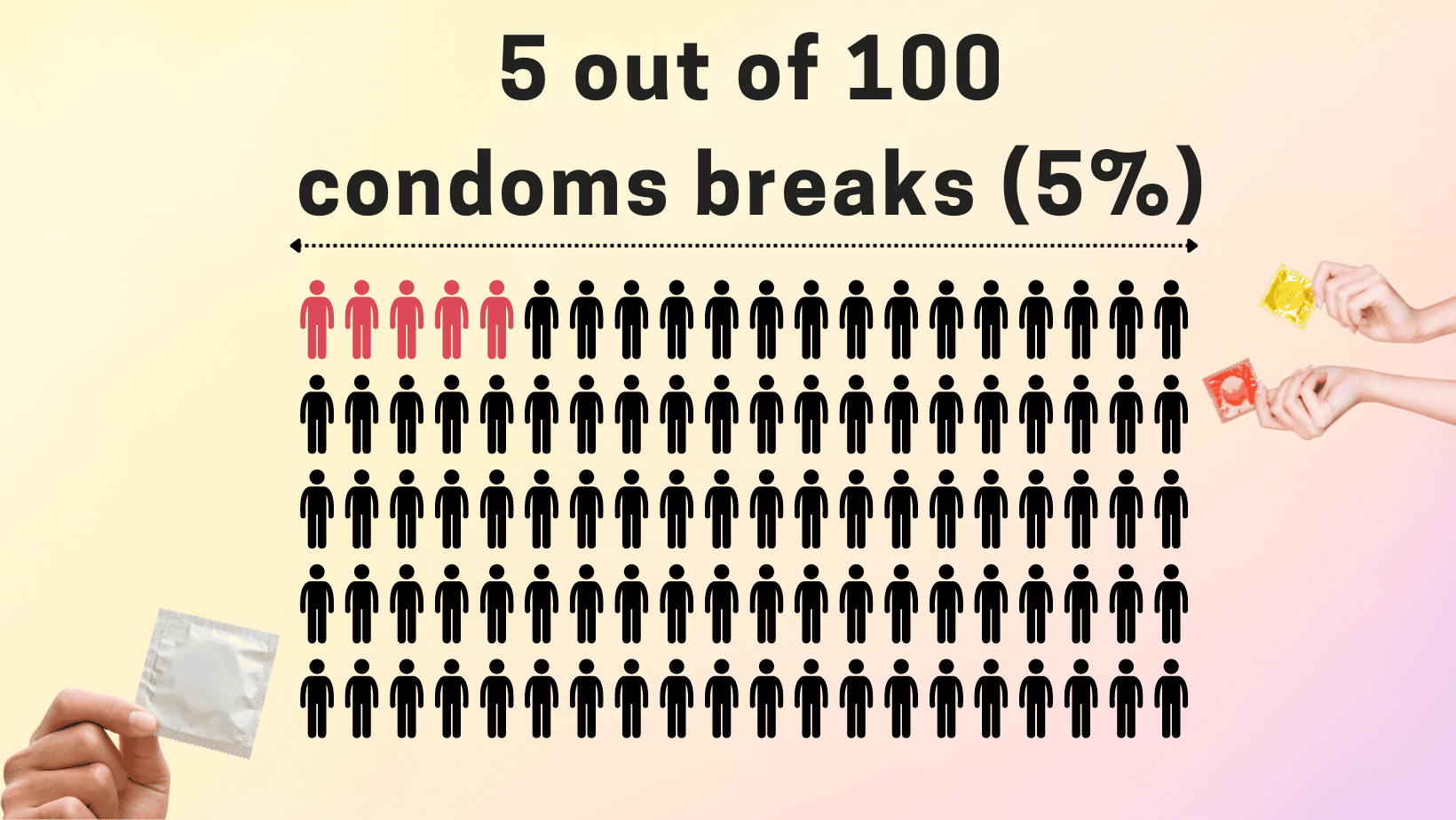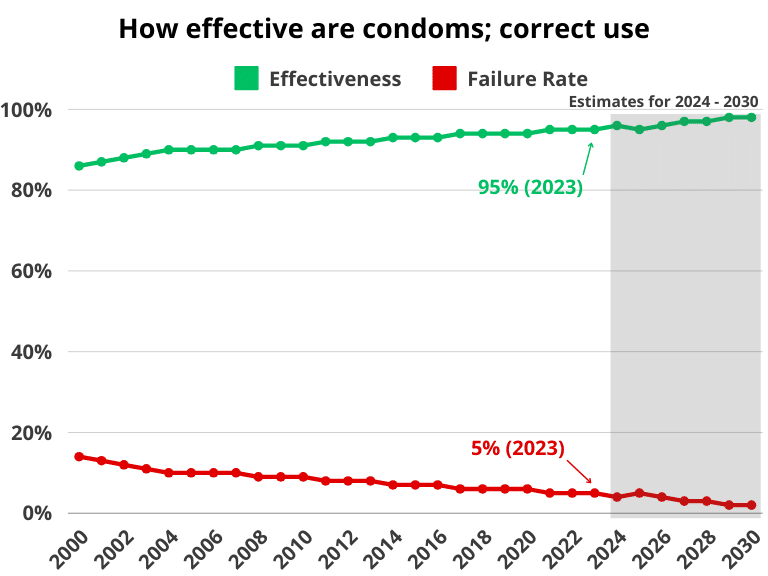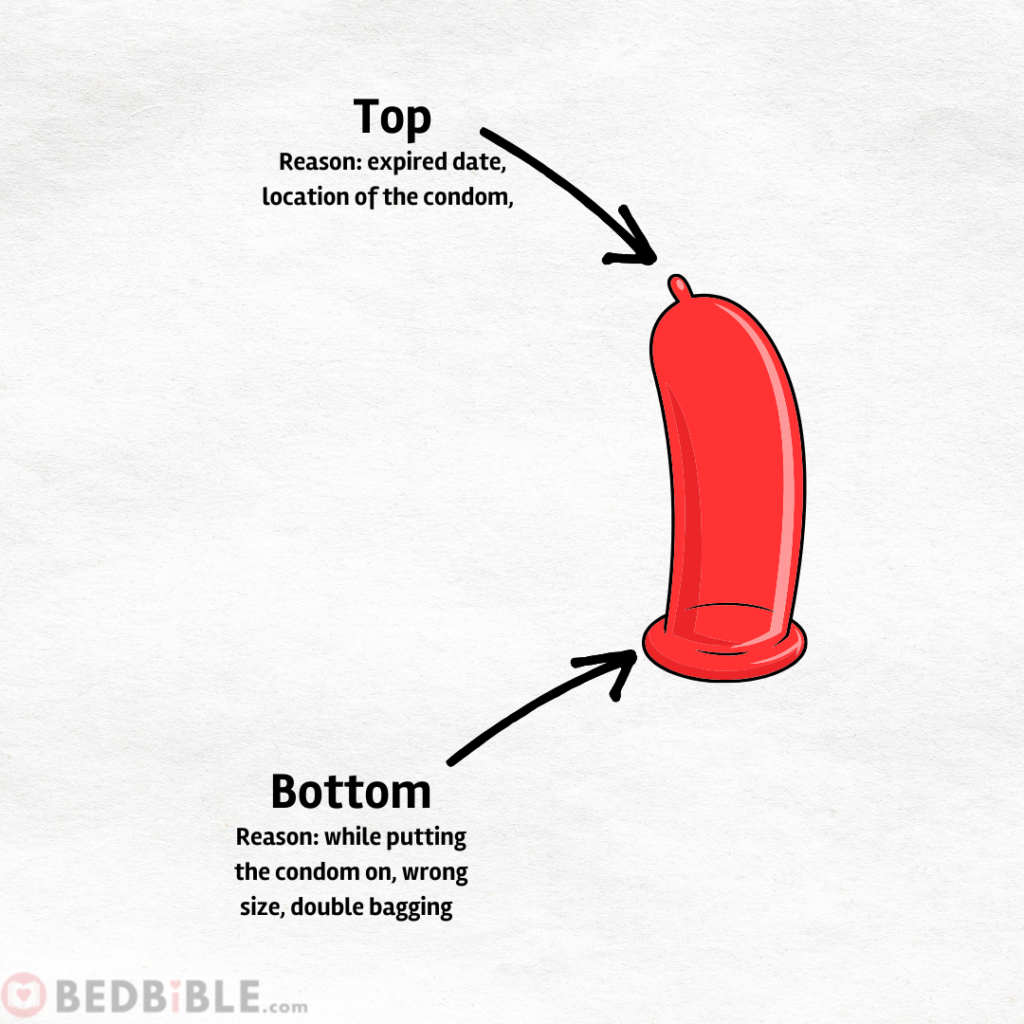
Are you looking for an answer on: How often do condoms break? Why do condoms break? And how do condoms break? Then you’ve come to the right place…
Our team of 2 journalists, 1 sexologist, and 3 data analysts have researched the internet and also conducted our survey consisting of more than 215.000 participants.
Just relax … we can already now say that it’s only 5% of all condoms break during sex. So if you’re in doubt about whether it happened. Then relax… it’s most likely that the condom didn’t break. Read why and how they break further down.
Table of contents:
- How often do condoms break?
- Why do condoms break? Why are they not 100 percent effective?
- How can you reduce the risk of breakage?
- How and where do condoms break?
- You’ll know if the condom breaks!
- It happened … I didn’t recognize it broke. What to do?
Data & Methodology
- A survey with 215.000 respondents
- 90% of respondents were from the US
- Research peer-reviewed with existing findings on the area to ensure that our data was reliable and trustworthy.
- Data is from the period 2020 – 2023 (this period is chosen due to the development of condoms changing rapidly, and it is therefore only relevant to look at newer years’ failure rate).
- Definition of condom breaking: When there is a hole in the material, and it, therefore, does not protect anymore
- The condom failure rate is both for vaginal- and anal intercourse as well as for oral sex. In other words, all kinds of sexual use of condoms.
How often do condoms break?
We’ll quickly start by giving you the answer: 5% of condoms break. That’s 5 out of 100 condoms. (This is all kind of sexual activity with the condom; Oral, Vaginal, Anal).
Bedbible Research Center
And our research shows that the majority of these 5% breaks are due to one primary reason. Read why condom fails and how they fail in the next headline.
Other condom break statistics with fewer respondents found the following conclusions on the chances of a condom breaking also known as the condom failure rate:
- The National Institutes of Health found that 7.3% of men have experienced a condom breaking, and 4.4% have experienced it slipping off.
- A survey asking around 1.000 women found that only 2% of them had experienced a condom breaking, and 1% had experienced it slipping off.
- And a survey among doctors found that the chances of a condom breaking were 3%.
| Condom Type | Typical Use Effectiveness Rate | Correct/Consistent Use Effectiveness Rate |
|---|---|---|
| Male Condom | 85% | 98% |
| Female Condom | 89% | 93% |

Why do condoms break? Why are they not 100 percent effective?
Condoms are 95% effective and secure to use. The last 5% is the chance that they’ll break, and you won’t recognize it.
They can break since it’s produced in a material that is created with pleasure in mind. In other words, the companies want you to have the best sexual experience, and the way to do that, is to make them super thin, so it feels like you didn’t wear one. The minor cons with this are that they are more exposed to getting damaged. But luckily is it, our survey only found that around 10.000 people out of 215.000 have tried it.
We’ve together with their explanation, doctors, and a sexologist listed why they broke (in the most frequent order). So number 1 is the reason why most condoms fail:
- (60%) Expired date of the condom (this makes the condom lube dry, which means that it can’t handle the stretch)
- (15%) Location of the condom (it can’t handle heat, sunlight, or friction. This will damage the material on it. So don’t forget it in the car where it’s super hot in the summer, in your wallet where there is friction, etc.)
- (12%) While putting the condom on (Read how it should be placed, and be aware of sharp nails when opening it or when placing it on the penis)
- (8%) Don’t use Oil-based lube while having a condom on (Oil weakens latex. Use silicone or water-based lube instead. )
- (3%) Wrong size (Primarily if you buy a minor size than what you need)
- (1%) Double bagging (Never put two condoms on at the same time)
- (1%) Other
How can you reduce the risk of breakage?
It is possible to lower the probability of breaking a Condom. The best way is to try to avoid the above-mentioned errors. You can do this by:
Step 1: Buy the correct size. You can find a size chart here.
Step 2: Look at the exploration date, and do online buy/use ones that are not too old.
Step 3: When opening it; be careful not to have sharp nails or stretch the condom too much. Or do not open it with your teeth (this can be fun, but chances are that you damage the condom).
Step 4: Put the condom on correctly (look at the condom before applying it).
Step 5: Use silicone- or water-based lube together with the condom.
Another good tip is to take a look at our top ranking of the best condoms.
How and where do condoms break?
The condoms often break at the top or the bottom (see below figure).
So these are the places you will look for breakage.

You’ll know if the condom breaks!
When condoms break you’ll not be in doubt. 9 out of 10 persons figure it out before it’s too late either by feeling it break or seeing the damage between different sex positions.
But but but … it is possible for a condom to break without you recognizing it. But it’s a super rare (10%) probability for that. In other words, there is a 5% probability that the condom first breaks, and then after that rare incident 10% probability of not finding out. So please do not be stressed about that.
It happened … I didn’t recognize it broke. What to do?
You’ve been super unlucky and didn’t recognize it broke. What to do now?
Step 1: Are you on birth control? If yes, don’t worry about the pregnancy. Now only think about STDs (Sexually transmitted diseases) – GO TO STEP 2 IF THE PARTNER IS ON BIRTH CONTROL.
Step 1.1: If you are not on birth control and don’t want to be pregnant. Take an EC pill (Emergency contraception). You can read more about them here: https://www.healthline.com/health/healthy-sex/pregnancy-scare
Step 1.2: If you forgot to take an EC pill, or if it’s too late. Then follow your cycle closely, and take an OTC pregnancy test on the first day you miss your period. And wait for the result. If the pregnancy test is positive take another one to validate the result. If that is also positive contact your doctor.
Step 2: You’re not pregnant but worried about STDs. To be 100% sure we recommend that you contact your doctor and get a test for HIV, Chlamydia, etc. This is the only way that you can be 100% sure and thereby can relax in your mind.
Types of condoms
- Normal condoms
- Ribbed condoms
- Thin condoms
- Small condoms
- Condoms for sensitive skin
- Condoms to last longer
- Vibrating condoms
About the lead researcher

The lead researcher is Jacob. He has a Master’s in Science in Business Intelligence and is one of our most experienced researchers. You can find more from Jacob here: https://bedbible.com/statistics/
Jacob created the newest and most comprehensive condom industry statistics last year and does therefore have a lot of knowledge about this topic.
Feel free to contact him at: jacob@bedbible.com for questions about this Condom Failure Rate Statistics. You can also get his dataset to send if you’re interested in that.
